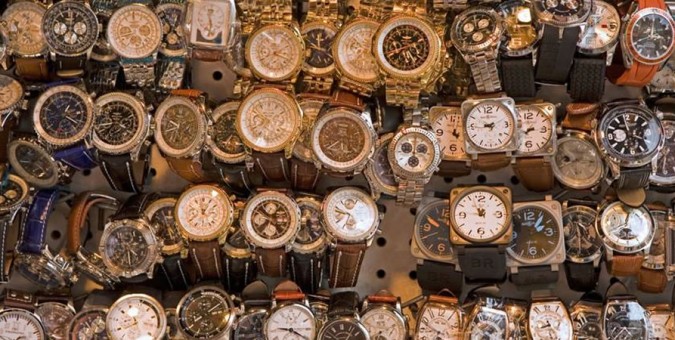
The Swiss watch industry is not in great shape. In March, as the biggest brands unveiled their shiny new timepieces in Baselworld’s equally shiny pavilions, its exports slumped 16 per cent compared to the same time the year before. But it’s not just contracting Asian economies and the rise of smartwatches eating into profits.
The fake watch market is estimated at around a $1bn a year – roughly a twentieth of the legitimate Swiss watch industry. According to some reports, as many as 30 per cent of watch searches are for replicas. Which means there’s a lot of fakes out there to snare the unwary. And spotting them is getting tougher. A couple of decades ago, you knew that ‘Bolex’ you bought in the airport probably definitely wasn’t legit. But Chinese gangs have honed their craft, employing expert watchmakers to craft timepieces near-indistinguishable from the real thing.
A few years ago, Swiss customs snared a Hublot Big Bang with a vanilla-scented strap – just like the original. Inside, even the movement passed muster; a perfectly assembled tourbillon, where you’d expect giveaway quartz. Only a nonreflective piece of crystal tipped off investigators. To make sure your heirloom doesn’t turn out to be a horological mistake, learn a lesson from some the UK’s leading pre-owned watch experts and learn to sort the Frédérique Constants from the Frankenwatches.
(Related: The watches you can pass down to your kids)
Location, Location, Location
If that Paul Newman Daytona is one of four laid out on a blanket, then odds are it’s not authentic. But just because a watch is behind glass, that doesn’t mean it’s the real deal. Unless your dealer is affiliated with the brand, you can’t guarantee what they promise is what you get.
Ask in store for what marque’s they’re licensed to sell and double-check on the watch brand’s official website.
Don’t Be Greedy
Watches make smart investment pieces because they hold their value. So be wary of sellers who don’t know what a Rolex is worth.
“If it’s too good to be true, then it generally is,” says Tim Pavy, product and sales manager at The Watch Gallery. “If you’re saving more than 25 per cent of the current market value of a similar model, it’s unlikely to be the genuine article.”
Be There
A picture tells a thousand words, and most of them are lies. “Lack of detail in the photograph can be an indicator the seller has something to hide,” says Pavy.
If the images are blurry, or they’ve not shot every angle, be wary. “A watch shown without the original box and papers can also sometimes indicate a lack of legitimacy.”
If you can’t buy in person, head to an approved online reseller like the The Watch Gallery, one of the few pre-owned web retailers authorised by the big luxury watch brands.
(Related: The beginner’s guide to buying a second-hand watch)
Weight It Out
Away from the near-legit superfakes, counterfeiters use cheap materials to save costs, so forgeries tend to feel lighter than the real deal. They’re rougher, too. “One of the hardest parts of making a genuine watch is the hand finishing, a process that cannot be replicated by machine,” says Watchfinder founder Lloyd Amsdon.
“A fake will often feel sharp on the edges, a sign it hasn’t been properly hand finished.”
Face Facts
Take a loupe to the dial and look for any mispositioned letters or missing details. Luxury watches are sold on perfection; if your Audemars Piguet’s logo is out of alignment, it’s a fake, not a mistake.
“Good dial printing is a very hard thing to achieve for the prices fake watches sell at, and the fonts are usually proprietary to the brand,” says Amsdon. “That means a fake will have inconsistencies.” Before spending, search for an image of a legit dial (again, the marque’s official website is a good place to start) and compare every detail.